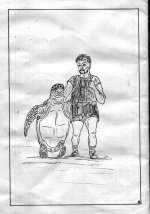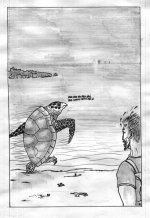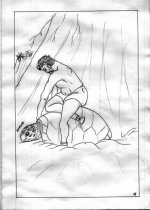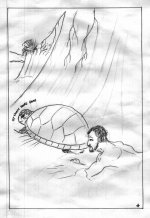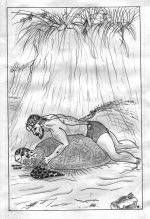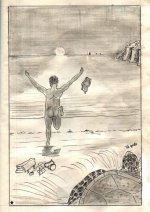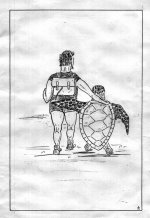Thank you everyone, so glad you enjoyed reading my story of my childhood patch. This next story is about my first patch in Western Australia and around about the year 1972. If there are any "Sandgropers" (Western Australians) reading this then the place I am describing is in the period when the top of Marmian Avenue was at Burns Beach Road.
-----------------------HIDDEN EYES ARE WATCHING.
As I lay on my bed on this spring morning, listening to the Singing Honeyeater and Magpies serenading the rising sun which beams through the chinks in the curtains, I felt the urge to get out and go for an early walk in the bush, an urge to wander free among the flowers and birds, to wash away the dust of civilization and blend in harmony with the wilderness, to stalk and watch the wild things, and be watched in return by those creature’s that seem to be there but never seen, those that lurk in the depths of the impenetrable scrub.
I sprang from my bed and dressed hurriedly, the urge strong within me, I did not want to waste a moment longer. After grabbing a mouthful of cereal and a cup of Green Tea I donned my strong bush boots, slung my binoculars around my neck and my note book in my pocket, and stepped out of the house and breathed deeply the flower flavored air.
I bounded through the suburbs, passing children going to school, their tinkling laughter and youthful innocence seemed to blend with the glory of this spring day. The roadside was festooned with colourful Gazanias, those daisy like flowers from Africa who have taken so readily to our West Australian climate, so readily in fact they could be considered an introduced pest as they smother the native flowers. They nod their heads of varying colours and grin to the sun. Pottering among the flowers were a few Senegal Doves, another introduced species, pastel shades of their plumage contrasting with the brilliant yellow, white, maroon and copper of the flowers.
The Welcome Swallow calls “tsee, tsee” as it flits about the houses, I can almost hear the lisp of its wings as it flies close by.
I reached the end of the bitumen road and it continued on as a disused trail into the virgin bushland that is hardly touched by the hand of man. Sadly, in the near future all the bushland on this coastal corridor will become mile upon mile of suburb after suburb of houses and shopping centers. The creatures living here at the moment will be pushed father and farther away as humans destroy in the name of progress.
Wandering up that trail the sound of human activity diminished and was no more. I wandered over a small hill and down into a hidden valley. The contrast from suburbia was almost overwhelming; I sat on a bank side, saturating my senses with its splendor. The air vibrated with life, a scratching, rustling, growing, oozing life. The scrub about me, droned, buzzed, twittered with insects and birds. I sat there for ages till I became blended, a part of the scenery. Civilized man drained from me and I regained lost primitive urges, ancient stirrings of a predator entered my consciousness, they coursed through my vein and mind. When I arose I did so with stealth, each step carefully placed. A Brown Honeyeater changed its sweet song to a harsh warning call, as if it knew what I had changed into.
I moved on silently, constantly stopping, lifting the binoculars to my eyes, peering into the depths of bushes and making notes of the birds and other interesting creatures that I saw.
I playfully teased the Trigger Plant by touching it’s nervous spot with a bit of straw, this caused the pollen filled pod to snap over, if it had been a fly then the pollen would have stuck to the insect and be carried to another Trigger Plant.
The Red Wattlebird “clacked, clacked” among the flowering Driandra, then mobbed a passing Nankeen Kestrel. A young Pallid Cuckoo squeaked incessantly, driving its foster parents, the Western Silver-eye to distraction in their efforts to satisfy the youngster’s insatiable appetite.
From the depths of a dark impenetrable area of prickly scrub issued an almost inaudible high pitched volume of squeaks that seem to float on the air and almost impossible to pinpoint. For fully five minuets I squeaked back by sucking the back of my hand. Eventually I saw a flash of beautiful blue and white, it was the White-winged Blue Fairy Wren, the male is sky blue with white wings, while the females are grey and white with a blue tail. My squeaking had drawn other inquisitive birds to the sound. The cheeky, bold Western Spinebill dashed hither and zither around me along with the, drab grey Western Thornbill, then the Scarlet Robin in it’s striking plumage of black, white and red. Followed by its cousin the Hooded Robin in just black and white. The final two were the common Rufous Whistler and the unafraid Grey Fantail that almost landed on my shoulder in its search for the source of the squeaking.
The sandy trail I walked along was patterned with the large prints of the Western Grey Kangaroo and the smaller prints of the Brush-tailed Wallaby, mingled with them were prints of the introduced Rabbit and Goanna Lizard. Smaller tracks were of the Bobtail Lizard, Skinks, Beetles, Bull Ants, Giant Centipedes and the occasional trail of a Snake. In damper spots the raised up twisting trail of the Sandgroper, or Mole Cricket, came to an end with the foot and wing print of the Kookaburra who must have seen the slight movement under the sand. I too saw movement along one of the trails and ran my finger along till I unearthed the mighty Sandgroper, all three inches of him. How vulnerable he is above ground, soft and succulent to his foes, his two front paddles dig into my hand with amazing strength and within seconds of putting him down he disappeared, like he was doing a breast stroke into the sand.
The dense scrub along the trail gave way to waste high heath land with pockets of Banksia trees and Blackboys, or Grass trees, a kind of primitive Lilly. This is the favorite haunt of the Tawny-crowned Honeyeater and Masked Woodswallow with an occasional Australian Pipit who use the exposed limestone outcrops as a nesting site.
From the top of a limestone hill I heard the persistent ‘caw” of the Australian Raven and my attention is drawn to two large birds wheeling in the sky. Through my binoculars I see the Raven is mobbing the mighty Wedgetail Eagle who soon out climbs his antagonist. Held beneath the Eagle, and grasped in his talons dangled the form of a rabbit; he certainly was reluctant to relinquish his hard earned meal to that silver-eyed black tyrant.
The Raven can be an asset to a bird watcher because of his antagonistic attitude towards the larger birds of prey, his constant calling as he pursues them draws ones attention, twice more today I observed him, first with a Brown Goshawk who screamed in fury and twisted and turned to avoid attack, then later I saw a Raven chasing a Whistling Kite. On all occasions the only way to free themselves from the pursuing, persistent black fiend was to gain height.
I left the well-worn trail and walked along an old track that was overgrown and barely visible. New-Holland Honeyeaters fluttered all around me, bright yellow, black and white, always singing and twittering. From the bush ahead flashed a brilliant blue, the Splendid Fairy Wren in all his glory. No blue could be as bright as the blue of this bird. This wren just has to be my favorite bird in Australia. For a moment he perched there in full view then lifted his head he ‘trilled” his song and then disappeared followed by the ghostly forms of the females who silently “twitter” from the depths of the scrub.
The track came to an end and I was forced to blunder on through the shoulder high prickly scrub, stealth and caution thrown to the wind as I struggled on, trying to avoid the prickliest bushes such as the Parrot bush, and hoping desperately not to step on a snake. The Dougite is the most common snake and there are plenty of them about. Nearer the swamp areas can be found the Tiger Snake, one of the most deadly of snakes.
The Death Adder is another bad one, it will lie in the track and pretend its dead, waiting for its prey to come close, and any unwary person can easily tread on them. I made my way to a stand of Banksia trees knowing it would be easier to walk beneath the outstretched limbs. Just as I reached the trees I got the biggest fright of my life, a large male Western Grey Kangaroo was sleeping right in my path, he stood up to his full height of about six feet and was not more than ten feet from me. Braced on his tail he rose before me, forearms level with my head, his chest broad and strong, nose twitching, trying to get my scent but the breeze was from him to me and I was the one who got the unmistakable musky Kangaroo smell in my nostrils. I had frozen still from the moment I detected him getting up. As we stared at each other many thoughts flashed through my mind in those few seconds. He was bigger than me and far more powerful. The ancient primitive urge to defend myself surged through me and I turned to look for a weapon. He instantly took fright and with great bounds disappeared into the scrub. The Western Grey is the largest Kangaroo and I think I had just met the granddaddy of them all. My legs turned to rubber and for a while I rested beside the cleared sand pit where he had been sleeping, his strong odor still on the air. I imagined him laying there, flicking sand over himself at the flies, especially the big spiky Clegs that were pestering me right now. Another spiky creature was also attacking me but is such a sneaky creature that I was not aware of it’s attack, it was the tenacious Tic who sits on the outmost twigs of a bush waiting for a passing Kangaroo, or Human to fall onto as they brush past. It then crawls around till it finds a suitable spot on the skin where it probes into the flesh and injects a solvent that prevents the blood from congealing, there it sits, slowly sucking the blood, its body swelling larger and larger till it is eight or nine times bigger than original size. When I got home that day I discovered eighteen of them on my body. Many more on other occasions, a hazard of birdwatching in the Australian bush.
Over the hillside with screeching cries flew a flock of White-tail Black Cockatoos, they landed in the Banksia Trees and Parrot Bushes around me, they then proceeded to wreck havoc in their feeding. The seed cones were snapped off with their powerful beaks and demolished in their search for the nuts within. When finished they drop the remainder of the cone and I could hear them “thunk” onto the ground like a fall of heavy hailstones. When a flock of these birds are feeding they always have a sentinel on watch, perched on the highest branch. I was soon spotted and the alarm was given which resulted in the whole flock of about five hundred taking to the air in a bedlam of calls, the male call similar to “kaliwoo” and the females call “Eerk, eerk”. The flock drifts over the landscape like a dark cloud.
The plaintive call of the Golden Bronze Cuckoo soon draws my attention and I imitate the call, this never fails to lure the bird to me and soon I saw it flying my way in its dipping flight and land in a tree close by. I call again and it answers with a different note while flapping its wings, which flash the iridescent green and bronze, with continuous calling I lure this bird as close as ten feet away before it realizes its mistake and flies off.
Western Australia is called the Wildflower State and the profusion of exotic flowers is a sight to behold. So many different Ground Orchids, some called Spider Orchid, or Donkey Orchid or even Rabbit Orchid, and others so small like the two inch high Duck Orchid. Day Lilies with their delicate blue flowers that open in the morning only to die when the sun gets too hot about midday. Kangaroo Paws in splendid green and red stand proud as if knowing we Western Australians honour them as our State Emblem. Frilled lilies drape over dead branches giving a gay colour to the sun bleached grey of the bark. Flowers of bright yellow stand bright against the blackness of old burned grass trees and the succulent Pig Face drapes the land with large yellow flowers, many other flowers with no common name or names unknown to me because of the abundance of species, scatter throughout the bush at this time of the year. Spring in Western Australia is a magnificent sight, but sadly it only lasts for a short time, about two months, if that.
I soak in the beauty of this natural garden in a stupefied trance until I became aware of those hidden eyes that seem to be watching, a prickling sensation ran up and down my spine. I forgot the flowers and searched the bushes and trees. I searched and searched for minuets on end but could not shake off the feeling. Through the binoculars I covered the near bushes and the far trees but saw nothing until a nagging, questioning feeling drew my attention to an unusual small jutting piece of wood on a branch in a Banksia Tree about thirty yards away. I approached slowly and the piece of wood on the thick branch seemed to grow elongated. I stood beneath the tree and recognised the unique posture of the Tawny Frogmouth on the branch above. The bird was sitting on its nest. When I moved back and forth beneath her, I could just make out a discernable movement of the head as she followed me. I looked around for the birds mate, as I knew he must be quite near. I soon found him in a tree nearby, looking like another stump of old wood. As I walked away the birds eyes became wider and wider and when at the original place where I first saw them I could see through my binoculars her eyes were wide open and looking at me.
I slowly made my way home, speculating to myself on the wonder of nature, and thanked the powers that be for showing me the answer to those mysterious unseen eyes that one usually feels but does not see.
The next day I returned to the Frogmouths with my brother and took a wonderful series of pictures of the bird and later wrote a poem about the incident.





